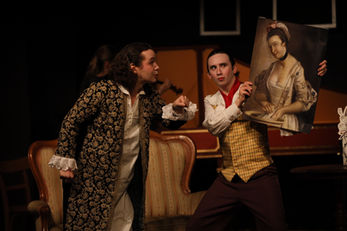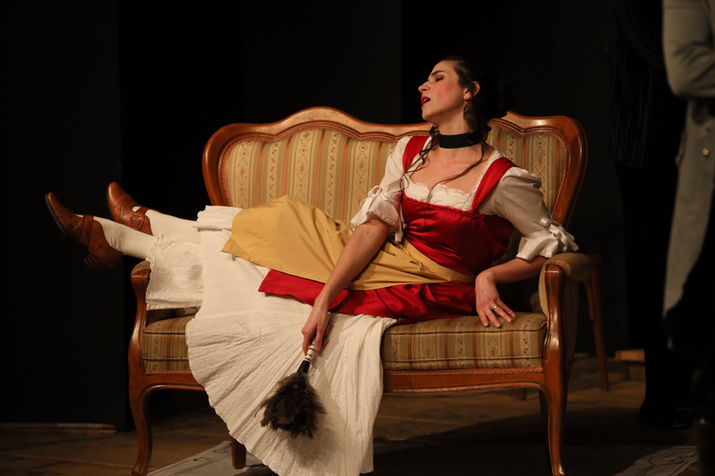
G. B. Pergolesi
Barocktheater Lambach OÖ | Concept & Scenic Direction
Intermezzo 1
The story tells of how Uberto, the master of the house, is very impatient with his maid Serpina because she has not brought him breakfast today. Serpina is so sure of herself that she thinks she is the master of the house. Uberto tells of his feelings and complains in the aria "Sempre in contrasti". When Uberto calls his other servant Vespone and asks for his hat and coat, Serpina forbids them to leave the house, adding that from now on he must obey her ("Stizzoso, mio stizzoso"). Uberto then orders Vespone to find him a wife to marry so that he can get rid of Serpina.
Intermezzo 2
Serpina persuades Vespone to convince Uberto to marry her. He pretends to be a soldier who Serpina's hand in marriage.
Serpina informs Uberto that she will marry a soldier named Tempesta. She will leave the house and apologises to her boss for her bad behaviour ("A Serpina penserete").
Vespone arrives, disguised as Tempesta, and without saying a word, demands 4,000 crowns as a dowry. Uberto refuses to pay such a sum. Tempesta threatens that he will
either pay the dowry or marry the girl himself. Uberto agrees to marry Serpina.
Serpina and Vespone expose the fraud; but Uberto realises that he has loved Serpina from the beginning. Serpina will now be the true mistress of the house ("Caro, Gioia. Oh Dio").
Ensemble
Serpina : Ayelen Mose
Uberto : Ivo Kovrigar
Vespone : Philip Guirola Paganini
Music Ensemble Seyltanz. : Anna Schiffkorn - Barockcello
Jennie-Marie Faderl - Barockvioline
Andreas Stoeger - Cemballo
Scenic Direction : Nais Leal
Costume & Stage design :Paula Castellano
Info: La Serva Padrona - Barocktheater Lambach
Impressions from the school students of the performance"La serva padrona" in Lambach









The concept
Nais Leal
The original story of La Serva padrona by the librettist Gennaro Antonio Federico presents some themes that are no longer appropriate for performance to audiences nowadays. The aim of this scenic concept is to give a new perspective to the characters, especially the character of „Serpina", the female figure of the piece. This without changing the comic and simple character of the work.
In this version of Pergolesi's opera, themes such as female education, the impact of social changes on the everyday environment, the relationships between different social statuses, among others, are addressed.
The opera is set in Europe in the 18th century, a historical period that would lay the foundations for many of today's topics, where the ideas of change, freedom and equality were strong themes, but what role did women play in these changes?
In the everyday life of the household, salons emerged, spaces where political, philosophical, literary and artistic themes were discussed on an equal level, and where women were the hostesses of these events, which were part of the process of the propagation of new ideas.
The emergence of female figures in different fields, such as Olympe de Gouges, Mary Wollstonecraft, Émilie du Châtelet, among others. Although they were actively present in society, they did not have as much visibility as other thinkers of the time.
The main target of contextualising La serva padrona in this period is to give visibility to women as active figures in social change, whether on a large scale or in everyday life, and to give history a new gender perspective.